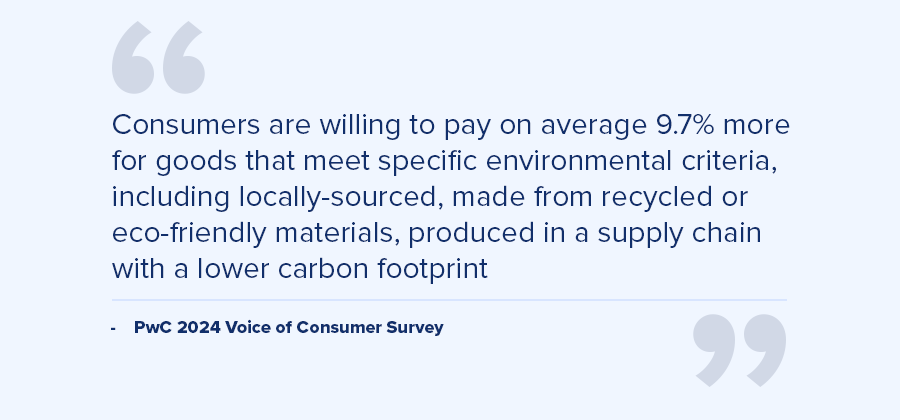Green Supply Chain Management: Why it is Important to Your Business?
Table of Contents
Green Supply Chain Management (GSCM) isn’t just a trend; it’s a revolutionized approach to building a more sustainable future. It’s about integrating environmental responsibility throughout every stage of your supply chain, from sourcing raw materials to final product disposal.
The main goal of Green Supply Chain Management is to reduce resource consumption, waste generation, and greenhouse gas emissions while ensuring social and economic sustainability. It goes beyond compliance with environmental regulations and aims to proactively seek environmentally responsible solutions.

What is Green Supply Chain Management?
Green supply chain management, also known as sustainable supply chain management, refers to the integration of environmentally friendly practices and principles into the design, planning, execution, and monitoring of supply chain activities. It involves considering the environmental impact of every stage of the supply chain, from product design and sourcing of raw materials to manufacturing, transportation, distribution, and end-of-life disposal or recycling.
Think of it as a holistic strategy that prioritizes:
- Environmental Friendliness: It focuses on adopting eco-friendly practices to minimize your environmental impact. This means reducing resource consumption, waste generation, and greenhouse gas emissions throughout the supply chain.
- Resource Efficiency: Optimizing processes and using AI-powered analytics helps businesses use resources more efficiently. This translates to cost savings alongside environmental benefits.
- Sustainable Practices: It goes beyond mere compliance with regulations. It’s about proactively seeking environmentally responsible solutions that create a long-term positive impact.
Why Green Supply Chain Management is Important?
Green supply chain management (GSCM) integrates environmentally conscious practices into every stage of the supply chain. It’s about making smart choices that protect the planet while driving business success. By adopting eco-friendly measures, businesses can lower their environmental footprint and meet the growing demand for sustainable operations.
GSCM matters because it tackles critical issues like greenhouse gas emissions, waste, and resource inefficiencies. Businesses that prioritize green practices not only contribute to a healthier environment but also build stronger reputations and long-term customer loyalty.
Benefits of Green Supply Chain Management
Taking the green route offers measurable benefits for your business and the environment. Here’s how green supply chain management (GSCM) delivers value:
- Cut Costs: Streamline operations to eliminate waste and optimize resource use, saving money at every stage.
- Strengthen Brand Loyalty: Demonstrating a clear commitment to sustainability attracts eco-conscious customers and strengthens relationships with stakeholders.
- Ensure Compliance: Stay ahead of tightening environmental laws and regulations to avoid penalties and disruptions.
- Enhance Resilience: Build a supply chain that adapts to climate-related risks, market shifts, and resource shortages, ensuring uninterrupted operations.
- Drive Innovation: Encourage the development of eco-friendly processes, products, and technologies that give you a competitive edge.
Every move toward a greener supply chain not only protects the planet but also secures your business’s future by improving efficiency, trust, and adaptability.
Green Supply Chain Management Strategies
Green supply chain strategies are about actionable changes that make a real difference. Here’s how you can implement impactful practices:
- Eco-Friendly Sourcing: Collaborate with suppliers who prioritize sustainable and ethical practices. Negotiate contracts that encourage long-term environmental benefits and align with your business goals.
- Reduce Energy Consumption: Invest in energy-efficient equipment and optimize transportation routes to lower emissions. Renewable energy sources should be considered for power operations and cut utility costs.
- Adopt Circular Practices: Implement recycling programs and reuse materials wherever possible. Encourage suppliers to adopt a similar approach to minimize waste across the supply chain.
- Leverage Advanced Technology: Use AI-powered tools to monitor supply chain activities and identify inefficiencies. The best TMS systems can revolutionize logistics planning by improving accuracy and reducing waste.
- Engage Stakeholders Actively: Build a culture of sustainability by involving employees, suppliers, and customers in your green initiatives. Regularly communicate goals and progress to maintain alignment and motivation.
Every initiative, whether big or small, strengthens your supply chain’s sustainability while reducing operational costs and enhancing resilience.
Types of Green Supply Chain Practices
There’s no universal blueprint for implementing green practices, but certain approaches consistently deliver results. Here are actionable strategies businesses can adopt:
- Sustainable Manufacturing: Transition to renewable energy sources, minimize waste during production, and use raw materials that are biodegradable or recyclable. Incorporate technologies like energy-efficient machinery to optimize processes.
- Greener Logistics: Use route optimization tools to reduce fuel consumption, invest in electric or hybrid vehicles for transportation, and consolidate shipments to eliminate unnecessary trips. These changes lower both costs and emissions.
- Waste Reduction: Establish company-wide recycling programs, repurpose production byproducts, and adopt minimal or reusable packaging materials. Encourage suppliers to integrate similar practices to extend the impact.
- Ethical Procurement: Partner with suppliers who meet rigorous environmental and ethical standards. Push for innovation by setting sustainability benchmarks in procurement contracts.
- Energy-Saving Facilities: Upgrade to automated energy management systems, switch to LED lighting, and implement real-time monitoring to reduce power wastage.
Adopting these strategies not only strengthens your business’s environmental commitment but also leads to measurable improvements in operational efficiency and cost-effectiveness.

From Green to Sustainable: Evolving Your Supply Chain Strategy
Transitioning from a green to a sustainable supply chain involves expanding your focus beyond environmental goals to include social and economic dimensions. While a green supply chain prioritizes reducing environmental impact through measures like energy efficiency and waste reduction, a sustainable supply chain integrates broader objectives such as ethical labor practices, community development, and economic resilience.
To evolve your supply chain strategy:
- Adopt a Holistic Approach: Address the entire lifecycle of your products, from sourcing to end-of-life disposal, ensuring ethical practices and minimal environmental harm at every stage.
- Set Integrated Goals: Align environmental, social, and economic objectives by targeting areas like carbon reduction, supplier diversity, and fair wages.
- Engage Stakeholders: Collaborate with suppliers, employees, and communities to build a transparent and inclusive supply chain. Ensure all stakeholders are aligned with sustainability priorities.
- Utilize Advanced Technologies: Leverage tools like blockchain for transparency, IoT for monitoring, and AI for process optimization to drive sustainability across operations.
- Monitor and Report Progress: Implement sustainability metrics such as carbon footprint, waste diversion rates, and supplier compliance to track progress and demonstrate accountability.
By broadening your perspective from green initiatives to a comprehensive sustainable supply chain strategy, you can create long-term value, mitigate risks, and contribute to a more equitable and sustainable future.
How Can Green Supply Chain Management Impact Your Business?
Incorporating green supply chain management can significantly influence your business and benefit your bottom line:
- Cost Savings: By optimizing energy and resource usage, reducing waste, and enhancing efficiency, green practices can lead to long-term cost reductions, ultimately boosting profitability.
- Enhanced Brand Reputation: As consumers become increasingly aware of environmental issues, adopting sustainable practices demonstrates your commitment to the planet, enhancing your brand’s reputation and attracting eco-conscious customers.
- Competitive Advantage: Implementing green supply chain strategies can set you apart in the marketplace. Many consumers prefer businesses that prioritize sustainability, providing a distinct edge over competitors.
- Regulatory Compliance: With governments enforcing stricter environmental regulations, aligning your supply chain with green practices ensures compliance, helping you avoid potential penalties and legal challenges.
- Risk Mitigation: Green supply chain management fosters resilience against risks associated with climate change and resource scarcity. By diversifying suppliers and utilizing renewable energy, you can prepare for potential disruptions.
- Innovation and Collaboration: Embracing sustainability often necessitates innovation and collaboration with suppliers and partners, leading to the development of new technologies and business models that can drive growth.
- Improved Supplier Relationships: Working closely with suppliers to meet sustainability criteria strengthens relationships and fosters trust, resulting in a more reliable and transparent supply chain.
- Life Cycle Assessment and Transparency: Assessing the environmental impact of products throughout their lifecycle allows you to communicate your sustainability efforts to customers, building trust and showcasing your commitment to responsible practices.
How to Achieve Green Supply Chain Sustainability?
To achieve green supply chain management, businesses must implement strategies that prioritize environmental sustainability. Here are key steps to consider:
- Assess and Map Your Supply Chain: Analyze all stages of your supply chain to identify areas with significant environmental impacts, such as transportation, packaging, and waste management.
- Set Environmental Objectives: Define clear, measurable, and achievable environmental goals for your supply chain, such as reducing carbon emissions or minimizing waste.
- Evaluate and Select Suppliers: Choose suppliers based on their commitment to sustainability and environmental performance.
- Optimize Transportation: Enhance transportation efficiency by minimizing empty backhauls, using alternative fuel vehicles, and optimizing routes to lower fuel consumption and emissions.
- Implement Waste Management and Recycling: Establish effective waste management practices, including recycling programs, and encourage suppliers to adopt similar strategies.
- Track and Monitor Performance: Use key performance indicators (KPIs) to regularly evaluate your environmental impact, identifying areas for improvement and setting targets for sustainability enhancements.
How Did This Global Brand Achieve a Green Supply Chain!
Adopting green supply chain management is essential for both our planet’s survival and the long-term prosperity of businesses. The environmental challenges we face today require a fundamental shift in how we produce, source, and distribute goods.
Green supply chain management allows us to reconcile economic growth with environmental sustainability. By integrating eco-friendly practices at every stage of the supply chain, we can minimize waste, reduce emissions, conserve resources, and protect ecosystems. This approach benefits the environment and creates value for businesses by fostering innovation, enhancing brand reputation, and opening doors to new markets.
FAQs
1. What is Green Supply Chain?
Green supply chain integrates sustainable practices into every stage of the supply chain. It focuses on reducing environmental impact, conserving resources, and ensuring ethical practices while maintaining efficiency.
2. How Can Green Supply Chain Practices Reduce Costs?
By optimizing resource usage, reducing waste, and adopting energy-efficient technologies, businesses can significantly lower operational expenses while improving productivity.
3. What Are the Key Benefits of GSCM for Businesses?
GSCM helps businesses save costs, enhance brand reputation, ensure regulatory compliance, build resilience against market disruptions, and foster innovation through sustainable practices.
4. How Do I Start Implementing Green Supply Chain Strategies?
Begin with a supply chain audit to identify inefficiencies. Collaborate with sustainable suppliers, invest in energy-efficient technologies, and set clear sustainability goals to guide your efforts.
5. Why is Stakeholder Engagement Important in GSCM?
Engaging employees, suppliers, and customers fosters collaboration and ensures everyone is aligned with your sustainability goals, creating a stronger, more unified impact.
Ready to build a sustainable, agile supply chain network? Discover how GoComet can help transform your operations. Contact us today to learn more!






